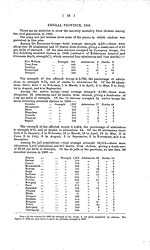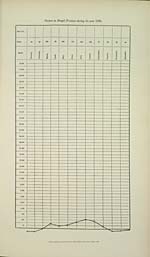Medicine - Disease > Cholera in India, 1862 to 1881
(34) Page 16
Download files
Individual page:
Thumbnail gallery: Grid view | List view

(16)
Tipperah
Strength
353
Admissions
1
Deaths
0
Dacca
449
6
5
Midnapore
814
42
23
Balasor
564
89
37
Cuttack
856
216
113
Puri
394
26
12
Ranchi
235
1
1
Hazaribagh
689
154
76
Monghyr
468
14
6
Bhagalpur
341
46
16
Purniah
343
2
1
Gya
649
22
12
Patna
571
47
18
Digah
605
78
28
Arrah
492
88
32
Champaran
286
20
14
Chaebasa
228
136
84
Muzaffarpur
457
74
17
Chaprah
499
82
19
The strength of the affected jails is 17,618, the percentage of admissions
to strength 8 03, and of deaths to admissions 44. Of the 1,415 admissions
there were 5 in January, 31 in February, 149 in March, 72 in April, 90 in
May, 207 in June, 396 in July, 303 in August, 70 in September, 28 in
October, 27 in November, and 37 in December. Taking all the figures
together, the monthly prevalence of the disease is shown in the accompanying
diagram. The districts shown above to be affected with cholera in 1866 are
marked on the map for that year.
The cholera of 1866 in the Bengal Province was coincident with a famine
in many parts of the country. The incidence of the disease among the jail
populations approaches in severity to the cholera of 1863 among the same
classes of the people. The figures clearly illustrate the manner in which
cholera mortality is aggravated by famine and a distressed condition of the
people. Throughout Bengal Proper cholera was generally prevalent in 1866.
It was confined to no particular season, but was generally most severe in
January, and again in the end of the year. The time at which it appears to
have reached its height varied, however, in different districts. In Balasore,
for example, it prevailed from January to June ; in Monghyr the most severe
epidemic was in August.
Throughout the famine tracts it raged with most virulence, and to this
disease, with dysentery and diarrha, a great part of the lamentable mortality
is to be ascribed. In the opinion of Dr. Sheridan, the Civil Surgeon of
Birbhum, the extraordinary causes which favoured the spread of these diseases,
and which were in operation over great part of the provinces were, first,
"A great death of food among the people, owing to a failure in the rice crops,
amounting in some parts of the district to actual famine and starvation ; ***
second, bad drinking water, owing to the early cessation of the rains in
September, and the long-protracted drought which followed, continuing up to the
first fall of rain in the middle of June, in consequence of which all the tanks
of moderate depth became partially or wholly dried up, rendering any water
remaining in them impure and unfit for drinking; *** third, exposure
to vicissitudes of weather and extremes of temperature at the most inclement
and unhealthy seasons of the year, owing to inability from extreme poverty
to procure warm clothing or covering. Want of shelter, too, on the part of
large numbers of the poor, whose miserable huts had been destroyed by the
unusually heavy falls of rain which occurred in the months of June and July,
and where not totally destroyed, inability to re-thatch fallen-in roofs owing
to the great scarcity and dearness of straw; fourth, innundations from the
overflowing of rivers, which cause great loss and damage to large numbers
living near them, in many instances destroying the small quantities of grain
that had been rescued from the previous year's scanty harvest ; fifth, con-
sumption of new rice by large numbers who had been for months previous
suffering from chronic starvation."
"Most of the medical officers," writes the Sanitary Commissioner for
Bengal, "from whom replies have been received, have expressed their belief
Tipperah
Strength
353
Admissions
1
Deaths
0
Dacca
449
6
5
Midnapore
814
42
23
Balasor
564
89
37
Cuttack
856
216
113
Puri
394
26
12
Ranchi
235
1
1
Hazaribagh
689
154
76
Monghyr
468
14
6
Bhagalpur
341
46
16
Purniah
343
2
1
Gya
649
22
12
Patna
571
47
18
Digah
605
78
28
Arrah
492
88
32
Champaran
286
20
14
Chaebasa
228
136
84
Muzaffarpur
457
74
17
Chaprah
499
82
19
The strength of the affected jails is 17,618, the percentage of admissions
to strength 8 03, and of deaths to admissions 44. Of the 1,415 admissions
there were 5 in January, 31 in February, 149 in March, 72 in April, 90 in
May, 207 in June, 396 in July, 303 in August, 70 in September, 28 in
October, 27 in November, and 37 in December. Taking all the figures
together, the monthly prevalence of the disease is shown in the accompanying
diagram. The districts shown above to be affected with cholera in 1866 are
marked on the map for that year.
The cholera of 1866 in the Bengal Province was coincident with a famine
in many parts of the country. The incidence of the disease among the jail
populations approaches in severity to the cholera of 1863 among the same
classes of the people. The figures clearly illustrate the manner in which
cholera mortality is aggravated by famine and a distressed condition of the
people. Throughout Bengal Proper cholera was generally prevalent in 1866.
It was confined to no particular season, but was generally most severe in
January, and again in the end of the year. The time at which it appears to
have reached its height varied, however, in different districts. In Balasore,
for example, it prevailed from January to June ; in Monghyr the most severe
epidemic was in August.
Throughout the famine tracts it raged with most virulence, and to this
disease, with dysentery and diarrha, a great part of the lamentable mortality
is to be ascribed. In the opinion of Dr. Sheridan, the Civil Surgeon of
Birbhum, the extraordinary causes which favoured the spread of these diseases,
and which were in operation over great part of the provinces were, first,
"A great death of food among the people, owing to a failure in the rice crops,
amounting in some parts of the district to actual famine and starvation ; ***
second, bad drinking water, owing to the early cessation of the rains in
September, and the long-protracted drought which followed, continuing up to the
first fall of rain in the middle of June, in consequence of which all the tanks
of moderate depth became partially or wholly dried up, rendering any water
remaining in them impure and unfit for drinking; *** third, exposure
to vicissitudes of weather and extremes of temperature at the most inclement
and unhealthy seasons of the year, owing to inability from extreme poverty
to procure warm clothing or covering. Want of shelter, too, on the part of
large numbers of the poor, whose miserable huts had been destroyed by the
unusually heavy falls of rain which occurred in the months of June and July,
and where not totally destroyed, inability to re-thatch fallen-in roofs owing
to the great scarcity and dearness of straw; fourth, innundations from the
overflowing of rivers, which cause great loss and damage to large numbers
living near them, in many instances destroying the small quantities of grain
that had been rescued from the previous year's scanty harvest ; fifth, con-
sumption of new rice by large numbers who had been for months previous
suffering from chronic starvation."
"Most of the medical officers," writes the Sanitary Commissioner for
Bengal, "from whom replies have been received, have expressed their belief
Set display mode to: Large image | Zoom image | Transcription
Images and transcriptions on this page, including medium image downloads, may be used under the Creative Commons Attribution 4.0 International Licence unless otherwise stated. ![]()
| India Papers > Medicine - Disease > Cholera in India, 1862 to 1881 > (34) Page 16 |
|---|
| Permanent URL | https://digital.nls.uk/74533636 |
|---|




